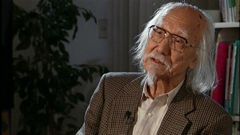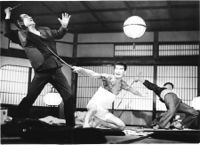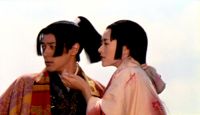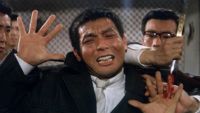
TIFF Cinematheque Presents - The Films of Seijun Suzuki
Toronto audiences and visitors get a rare chance to watch old Yakuza classics directed by Seijun Suzuki. The best thing about all this is that his films are very entertaining and a great fun to watch. Many, including myself are not that familiar with his films, us believing in the west and all, so this is a rare treat. The series begs January 30th with STORY OF A PROSTITUTE and runs all the way to march with breaks between the movies.
Capsule reviews are proved for 5 selected films, screeners provided courtesy of TIFF. As this reviewer is slumped with too many films and datelines, the capsule reviews will be posted at least a week before each of the selected films open.
For more details on ticket pricing, venue and complete program, please check the TIFF website tiff.net
Please note that this is a travelling retrospective programmed by Tom Vick, Curator of Film, Freer and Sackler Galleries, Smithsonian Institution, and co-organized with the Japan Foundation.
Also, the programmer’s essay by Todd Brown is reproduced here from the tiff website for your convenience. Mr. Brown penned the following paragraphs, and the capsule reviews are written by myself.
Programmer’s Essay:
This spotlight on the Japanese outlaw master spans his career from his delirious '60s yakuza thrillers to his late-career renaissance as an independent art-house filmmaker.
One of the true madmen of world cinema, Seijun Suzuki is the kind of director for whom the term "iconoclast" barely suffices. Beginning his film career at the famed production house Nikkatsu in the 1950s, Suzuki turned out over forty features during his decade-plus tenure with the studio — an incredibly prolific track record that was far from a rare instance at that time and place. Filmmaking at Nikkatsu was an assembly-line affair, with the prime jobs going to those directors who could churn out product on time, on budget, and within the parameters set out by the studio heads. As Suzuki grew bored with those parameters, his work took a turn for the weird, revelling in theatricality, self-conscious artifice, outrageous bursts of colour, and bizarre characterizations.
Putting Suzuki on notice to behave himself, the studio sought to rein him in by slashing his budgets and, after the pop-art opus Tokyo Drifter, forcing him to shoot in black and white. When Suzuki responded to these strictures by turning in the delirious hitman thriller Branded to Kill, he was summarily dismissed from Nikkatsu, sparking a legal battle that led to the director being effectively blacklisted from the Japanese film industry for a solid decade.
While Drifter and Branded have since been rightfully reclaimed as gonzo masterpieces, they are only the entry points to the life and career of one of cinema's greatest mavericks. From his earlier, equally remarkable Nikkatsu work, to his ambitious independent films in the 1980s, to his late-career renaissance with Pistol Opera and Princess Raccoon, Suzuki has proven himself to be an unstoppable creative force. The film world has never seen anyone like him and, with the now 85-year-old master in failing health, it likely never will again.
—Todd Brown
CAPSULE REVIEWS:
BRANDED TO KILL (Japan 1967) ***
Directed by Seijun Suzuki

BRANDED TO KILL stars Suzuki’s favourite actor the puffy faced Joe Shishido as a hit man (number 3 in the business), Hanada dispatched for various jobs. The story does not make much sense, but neither do many of Suzuki’s films. BRANDED TO KILL is especially stylized, Suzuki’s trait - the best of which include erotic sex on a spiral staircase fuelled by Hanada’s arousal by the fragrance boiling rice and an assassination via a billboard of a cigarette lighter. There are lots of action sequences, most of them comic style like the type adopted by John Woo who apparently was a fan of Suzuki. This film got Suzuki fired and blacklisted, but BRANDED TO KILL remains a cult classic for many cineastes. Tongue-in-cheek entertaining!
(Screening Mach 12)
KANTO WANDERER (Japan 1963) ***
Directed by Seijun Suzuki

A Yakuza film that centres on Katsuta (Akira Kobayashi) who is torn between the elements of loyalty and duty to his Yakuza boss. The plot is a bit complicated, though not difficult to follow with the action only taking place during the second half of the film, though there is not much of it. The film is more drama than action with Suzuki fond of utilizing the full use of colours, as in the Zakuza code of red and white. There is a lot in the film that will look foreign to western audiences like the gambling game of cards, which appear to be a Japanese staple game. Matinee idol Kobayashi is suitably gorgeous and masculine in his role while his counterpart Daizaburo Hirata is equally impressive as his rival, Diamond Fuyu.
(Screening Feb 20)
PRINCESS RACCOON (Japan 2005) ***
Directed by Seijun Suzuki

Suzuki’s arguably most outrageous and non-gangster film is as ridiculous (though entertainingly so) as its title. Prince Amechiyo is being hunted by his father for being too beautiful. A takeoff of Snow White with the Father wanting to be the fairest of them all thus wanting to kill his son for overshadowing him. Amechiyo tries to escape he runs into Princess Raccoon, a raccoon in human form. They fall in love for each other, but humans and raccoons should never mix so the raccoon court causes some trouble. She saves his life, then he saves hers by finding the Frog of Paradise on the Sacred Mountain and so forth, until the tragic finale. The film is full of outlandish sets, costumes, colour, dialogue and musical numbers. Truly Suzuki and truly a very different experience.
(Screening Apr 2)
TOKYO DRIFTER (Japan 1966) ***
Directed by Seijun Sujuki

TOKYO DRIFTER is the film resulting from the Nikkatsu Studios tightening the reigns on director Sujuki’s works. The result is a film that often makes no sense, is all over the place (there is an extended saloon brawl scene, musical numbers and ridiculous shoot-outs) and short of narrative continuity. Still watchable for all its bizarre segments, the plot if familiar, involves former yakuza hit-man Tetsu (blank-faced pop singer Tetsuya Watari, wearing a powder-blue suit), determined to go straight, but soon targeted by his former boss and an old rival for extermination. One never knows what to expect but the hero still comes out alive and gun blazing nevertheless.
(Screening March 10)
YOUTH OF THE BEAST (Japan 1963) ***1/2
Directed by Seijun Suzuki

Featuring Suzuki’s favorite actor Joe Shishido who plays a mysterious stranger (like the man with no name in the spaghetti westerns) who hires his muscle to two rival yakuza gangs, with very violent results that are typical in a Suzuki film. The other Suzuki traits are present like the vivid colours, hallucinatory shots and striking images lie the wester scene that could have been taken out of a John Ford classic. The story, based on a novel, revels the stranger to be an ex-cop, out for revenge of the death of his partner. Shishido is always a pleasure to watch, like a Japanese version of Clint Eastwood and not so pretty.
(Screening Feb 27)



Comments powered by CComment